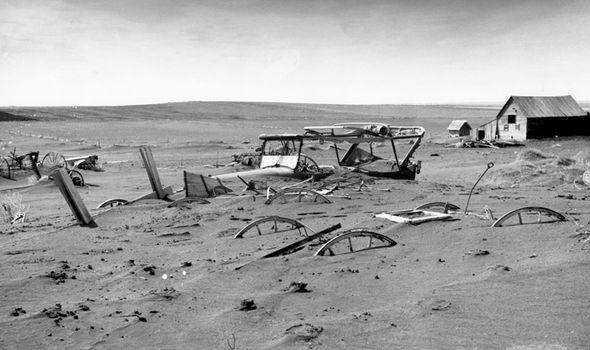 |
| Dust Bowl |
Dust bowl is a term coined by an Associated Press correspondent when he described the drought conditions that affected the residents of 27 states as they struggled to grow wheat in the unforgiving weather conditions of the "dirty thirties."
The American South, primarily the plains of Kansas, western Colorado, northwestern New Mexico, and the panhandles of Texas and Oklahoma, was the most affected area as a cyclical meteorological phenomenon dropped Pacific Ocean air far to the south, preventing the normal introduction of moist weather from the Atlantic Ocean into the Plains.
The national and international demand for wheat, a less drought resistant crop, was high during and immediately after World War I; Plains farmers, eager to reap high profits, began the "great plow-up" using poor farming techniques that led to soil erosion. Grasses and native plants that had served as windbreaks were overplowed in the quest to produce more wheat; farmers believed that "rain follows the plow."
  |
But the rain did not follow these farmers' plows; instead, it stopped. Amid record high temperatures, dust storms increased in number and intensity, carrying away millions of tons of topsoil and depositing the dust as far away as the East Coast. Before a storm, residents blocked their windows and doors with wet cloths but still shoveled dust out of their homes with wheat scoops afterward.
The American Red Cross issued calls for facemasks for children who were contracting "dust pneumonia," dead cattle were found with three inches of dirt in their stomachs, people spit up what looked like chewing tobacco, and starving jackrabbits came down from the hills to menace the land and devastate small gardens.
 |
| Machinery buried in dust bowl |
Frustrated and overwhelmed, one of four families left the area, earning the nickname "Exodusters." John Steinbeck's novel The Grapes of Wrath chronicles the Joad family as it migrated toward the West Coast in search of employment picking crops.
After Black Sunday, April 14, 1935, the date of the worst dust storm, a day many believed was the end of the world, the New Deal created programs that determined the farmers were responsible for soil and water erosion, and Congress established the Soil Conservation Service under the direction of Hugh Bennet.
New plowing techniques were initiated, lands were allowed to lay fallow, crops were rotated, plantings that retained topsoil were introduced, and a 100-mile-wide tree belt from Canada to Texas was proposed; these methods reduced blowing soil by 65 percent.
In the fall of 1939 the rains returned, and with the onset of World War II and the end of the Great Depression the Plains were once again flush with wheat.